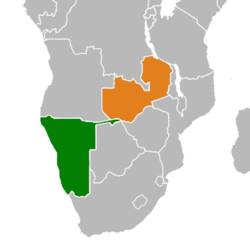Namibia–Zambia relations
Namibia–Zambia relations refers to the bilateral relations of Namibia and Zambia. Namibia and Zambia are separated by the Zambezi River. The Katima Mulilo Bridge connects Katima Mulilo on the Namibia side with Sesheke, Zambia.
 | |
Namibia |
Zambia |
|---|---|
History
Before Namibian independence (1880s-1990)
Zambia was known as Northern Rhodesia from 1911 to 1964. Namibia was known as German South-West Africa (1885–1915) and later as South-West Africa (1915–1989). Until 1964, both countries were ruled by white minorities, however, Northern Rhodesia gained independence in 1964, renaming itself Zambia. Subsequently, Zambia supported Namibian efforts towards independence from occupying South Africa. Namibia's primary liberation movement, SWAPO, was based from 1964–1975 out of Lusaka, Zambia's capital. The United Nations Institute for Namibia, which eventually became the University of Namibia, was based in Lusaka. SWAPO cadres received political and military training in the country. Upon independence in March 1990, Namibia and Zambia established diplomatic relations.[1]
Since Namibian independence (1990)
Trade
From 2004–2006, trade increased between the two countries from US$15.1 million to US$17.2 million with a trade balance in Zambia's favour.[1] In 2007, USAID supported increased trade relations between the two states.[2]
High Commissioners
Namibia's High Commissioners to Zambia include Martin Shalli and Commissioner Solomon Witbooi, who was appointed in April 2007.[3] Past top Zambian diplomats in Namibia include Mavis Muyunda[4] and Commissioner retired Zambia Army Commander General Isaac Chisuzi, who was appointed in December 2010.[5]
References
- Namibia-Zambia Relations Irreversible New Era, 20 June 2008
- USAID supports Namibia-Zambia trade relations Namibia Economist, 15 August 2007
- Witbooi of Gibeon made diplomat The Namibian, 21 April 2007
- President Banda hails Namibia-Zambia relations Statehouse.gov.zm, 24 June 2010
- Zambia: RB swears in Chisuzi as Namibia High Commissioner Lusaka Times, 22 December 2010

